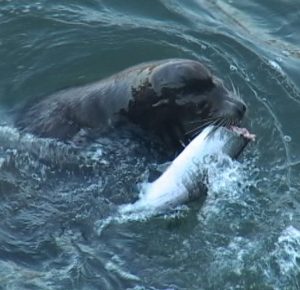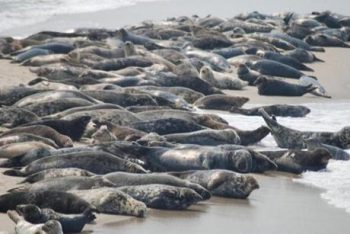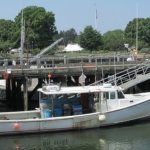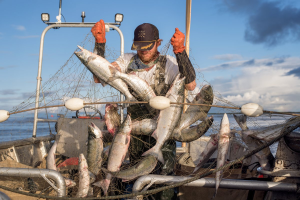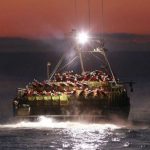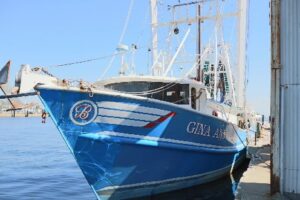Tag Archives: MMPA

Lawsuit filed to Protect Pacific Humpback from fishing gear, Can lawsuits save North Atlantic Right Whale?
The Center for Biological Diversity sued the National Marine Fisheries Service today for failing to protect endangered Pacific humpback whales from deadly entanglements in sablefish pot gear off the coasts of California, Oregon and Washington. According to Fisheries Service estimates, the sablefish fishery on average kills or seriously injures about two humpback whales every year. The fishery uses 2-mile-long strings of 30 to 50 pots. >click to read< Can Litigation Help Save the North Atlantic Right Whale From Extinction? – As conservation organizations and governments around the globe grapple with the devastating effects of climate change and overexploitation, the legal battle fought over the critically endangered North Atlantic right whale, one of the world’s most endangered large whale species, may provide insights into how litigation can help, or hinder, efforts to save species from extinction. >click to read< 13:41
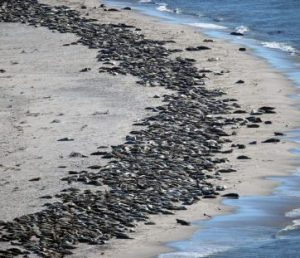
What Is the Marine Mammal Protection Act?
The Marine Mammal Protection Act, or MMPA, is the U.S. federal law restricting human actions that affect marine mammals. The MMPA was signed into law in 1974 by President Richard Nixon, making it one of many environmental policies established by the Nixon administration. One of the most significant actions taken under the MMPA was the establishment of an “optimum sustainable yield” (OSY). Instead of the traditional single-species approach to marine mammal management, OSY focuses on the role of marine mammals in the health of an ecosystem. The ecosystem-based approach remains widely implemented across the fishery industry today. >click to read< 11:03

Court Finds American Lobster Fishery Requires Incidental Take Statement for Impacts on North Atlantic Right Whale
As commercial fisheries across the United States continue to adjust operations in the face of new legal requirements, such as the shift from single-species to ecosystem-based management, one challenge in particular has dominated the courts: the Endangered Species Act (ESA). Recent court decisions have vacated commercial longline fishing permits in federal waters off the coast of California that could endanger the Pacific leatherback sea turtle and restored prohibitions on gillnet fishing gear in a known New England feeding ground for the endangered North Atlantic right whale. This trend continued on April 9, when a federal district court judge in Center for Biological Diversity,,,The American lobster fishery is managed cooperatively by the Atlantic States Marine Fisheries Commission and NMFS, >click to read< 14:45
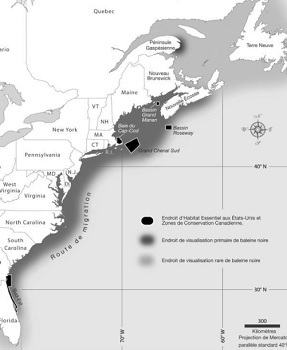
US elected officials discuss Canadian crab embargo
In a letter to Commerce Secretary Wilbur Ross, a member of President Donald Trump’s Cabinet, four elected officials from Maine stand up for their state’s lobster fishing industry. They argue that measures to protect the North Atlantic right whale imposed on American fishermen for several years have saved the species from extinction, but also increased its population. However, they add, the mortality of right whales “directly related” to commercial shipping and fishing activities in Canadian waters “continues to increase”. A total of 12 right whales died in the Gulf of St. Lawrence in 2017 and at least 9 in 2019, out of a population of around 400 individuals. >click to read<14:13
Des élus américains évoquent un embargo sur le crabe canadien – >click to read<
Most likely Carnival Cruise Lines is responsible for 18+ Right Whale deaths in the past 3 year, at which rate they would soon be extinct. – >click to read<

Senator Warren wants proof Canada is doing as much as the U.S. to protect right whales
Canada is defending measures it has taken to protect critically endangered North Atlantic right whales, as political pressure and blame mounts from the United States in the wake of a rash of whale deaths in Canadian waters in 2019. “We’re very confident that our measures are world-class in nature and stand up extremely well to those in the United States,” said Adam Burns, the Department of Fisheries and Oceans’ director of resource management. Burns was responding to the latest salvo from Massachusetts senators Elizabeth Warren and Ed Markey, who are threatening a ban of some Atlantic Canadian seafood products. >click to read< 19:08

Open Season: It might be time to ‘seal’ a deal to help fishermen
According to local lobstermen, the fishing in Buzzards Bay suffers a lull in the heat of late summer but usually picks up again around Thanksgiving when the water cools. But that’s not the case this year, according to my own experience. I have a recreational lobster license, which allows me to run up to ten pots with a stipulation that the lobsters can’t be sold. I run those ten pots in the Bay from spring through December and fished them as late as mid-January last year, but I hauled them for the season on Tuesday. It stopped being fun. For November and early December, my harvest was less than half of what I caught last year during the same period. Some say that the increase in ocean temperatures, due to climate change, is chasing the lobsters North to colder waters but it’s my opinion that the populations of lobsters, like any other wildlife species, are cyclical with highs and lows. Wildlife numbers are never stagnant. >click to read<18:33
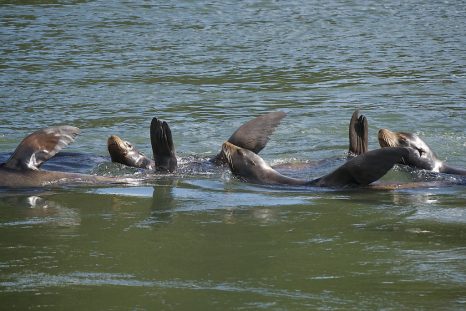
Sea lions moving into smaller streams – “They’re working on wild fish,”
In the past month or two, a few California (one Steller) sea lions have moved into the lower stretches of the Sandy River and as many as half-dozen (some say more) are devouring winter steelhead in the Clackamas River, as far up as Eagle Creek. Washington officials report sea lions prowling the lower Cowlitz, Lewis and Washougal rivers. And these aren’t just any winter steelhead tickling their palates. By this time of year, the earlier-arriving hatchery-origin steelhead run is largely finished, Todd Alsbury, department district fish biologist, told a group of sportfishing leaders in Clackamas. “They’re working on wild fish,” Alsbury said. “It could make Ballard Locks pale in comparison.” Remember Ballard Locks in Seattle? Apparently few, if any, real lessons were learned from the decimation of Lake Washington’s meager (2,000-3,000 fish) wild steelhead runs by Herschel and a handful of sea lions in the 1990s. Click here to read the article 14:12
Pricey sea cucumbers face increasing sea otter appetites
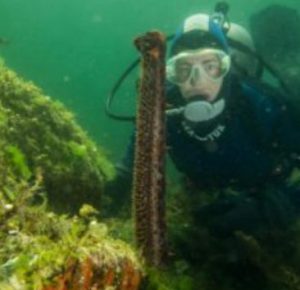 Sea cucumbers are the most valuable of Alaska’s dive fisheries and give a nice boost to coastal towns, especially in Southeast. Annual harvests each October hover around one million pounds and attract nearly 200 divers, who will fetch between $4 to $5 a pound for their pickings. The harvest used to approach two million pounds but sea otters have cleaned out cucumbers in many areas over the past decade. None of the areas they have gone back and resurveyed have they seen any sea cucumbers. It’s not like the otter come in and move on and the population rebounds. The otters stay. We’ve lost on an annual basis between 500-000 to 600,000 pounds of product and the trend is downward. Audio report, read the rest here 16:46
Sea cucumbers are the most valuable of Alaska’s dive fisheries and give a nice boost to coastal towns, especially in Southeast. Annual harvests each October hover around one million pounds and attract nearly 200 divers, who will fetch between $4 to $5 a pound for their pickings. The harvest used to approach two million pounds but sea otters have cleaned out cucumbers in many areas over the past decade. None of the areas they have gone back and resurveyed have they seen any sea cucumbers. It’s not like the otter come in and move on and the population rebounds. The otters stay. We’ve lost on an annual basis between 500-000 to 600,000 pounds of product and the trend is downward. Audio report, read the rest here 16:46
Recovery of Marine Mammal predators causes unexpected conservation challenges
 In the paper, published in the journal Conservation Letters, scientists explored the effects of these recovering predator populations on their home ecosystems, outlining three major unintended conflicts that have resulted. In the Pacific Northwest the comeback of California sea lions and killer whales, as well as Pacific harbor seals (Phoca vitulina), all protected under the MMPA, has increased the animals’ competition with humans for fish. Furthermore, all three predators feed on the ESA-protected Chinook salmon (Oncorhynchus tshawytscha), whose populations are declining. And competition for fish among the predators could adversely affect them all. Read the rest here 10:40
In the paper, published in the journal Conservation Letters, scientists explored the effects of these recovering predator populations on their home ecosystems, outlining three major unintended conflicts that have resulted. In the Pacific Northwest the comeback of California sea lions and killer whales, as well as Pacific harbor seals (Phoca vitulina), all protected under the MMPA, has increased the animals’ competition with humans for fish. Furthermore, all three predators feed on the ESA-protected Chinook salmon (Oncorhynchus tshawytscha), whose populations are declining. And competition for fish among the predators could adversely affect them all. Read the rest here 10:40New England Set Gear Fishermen – Final Rule – Atlantic Large Whale Take Reduction Plan. Are you Affected?
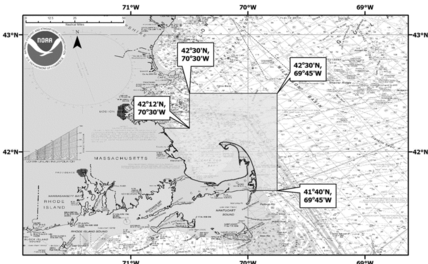 NMFS issues this final rule to amend the regulations implementing the Atlantic Large Whale Take Reduction. This rule revises the management measures for reducing the incidental mortality and serious injury to the North Atlantic right whale, humpback whale, and fin whale in commercial trap/pot and gillnet fisheries to further the goals of the MMPA, and the ESA. . Read final rule in the Federal Register 18:49
NMFS issues this final rule to amend the regulations implementing the Atlantic Large Whale Take Reduction. This rule revises the management measures for reducing the incidental mortality and serious injury to the North Atlantic right whale, humpback whale, and fin whale in commercial trap/pot and gillnet fisheries to further the goals of the MMPA, and the ESA. . Read final rule in the Federal Register 18:49
Draft Southeast Sea Otter Population Assessment Out
 The draft estimates a total of 25, 712 otters in the region. The number is based on aerial surveys done by researchers in 2010 and 2011. That compares with 10,563 otters in 2003. The otter’s rapid population growth and voracious appetite for shellfish has been a major concern for commercial crabbers, dive fishermen and subsistence harvesters. Listen, and Read more here alaskapublic.org 20:17
The draft estimates a total of 25, 712 otters in the region. The number is based on aerial surveys done by researchers in 2010 and 2011. That compares with 10,563 otters in 2003. The otter’s rapid population growth and voracious appetite for shellfish has been a major concern for commercial crabbers, dive fishermen and subsistence harvesters. Listen, and Read more here alaskapublic.org 20:17
Eco Based Management Failure: Otter battleground – Fishermen lose lawsuit in battle against sea otter; supporters relieved
 If you’re out surfing or walking along the beach, take a peek toward the Channel Islands. Among the seals, dolphins or rare whales, you might once again spot the California sea otter, due in part to the lifting of an artificial “no-otter zone” and a failed lawsuit to have it reinstated. Read more here vcreporter 12:18
If you’re out surfing or walking along the beach, take a peek toward the Channel Islands. Among the seals, dolphins or rare whales, you might once again spot the California sea otter, due in part to the lifting of an artificial “no-otter zone” and a failed lawsuit to have it reinstated. Read more here vcreporter 12:18
Great White Sharks Are Back – Has a marine mammal conservation program become too successful?
Gordon Waring, a seal specialist at the NOAA, cautions that marine biologists don’t actually know how seals interact with fisheries, and so far there is no sign that they are eating more than their habitat can support. (seal specialist??,,don’t actually know??) wow. continued@ slate






